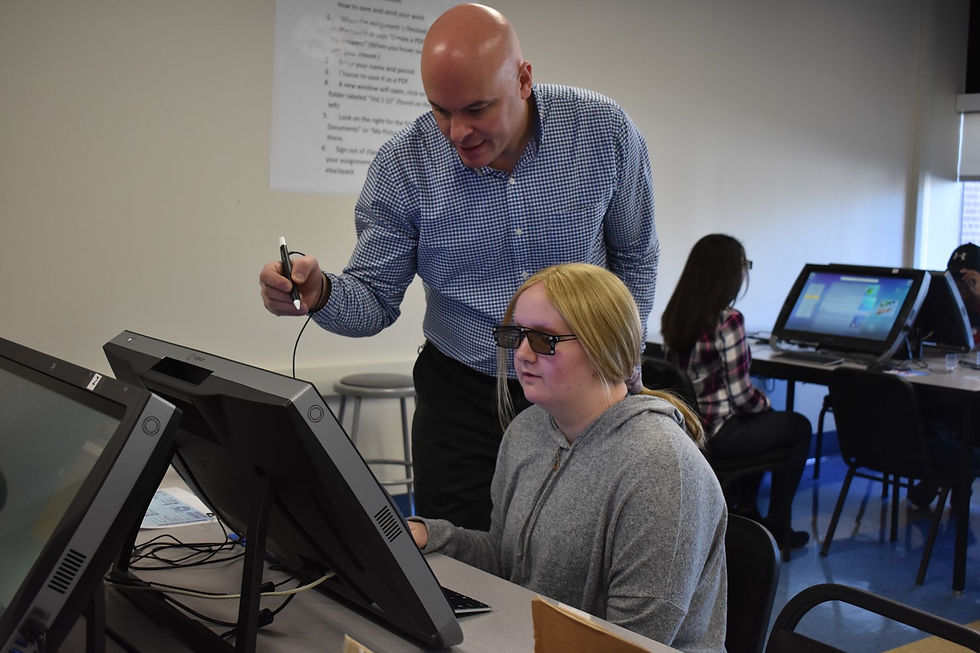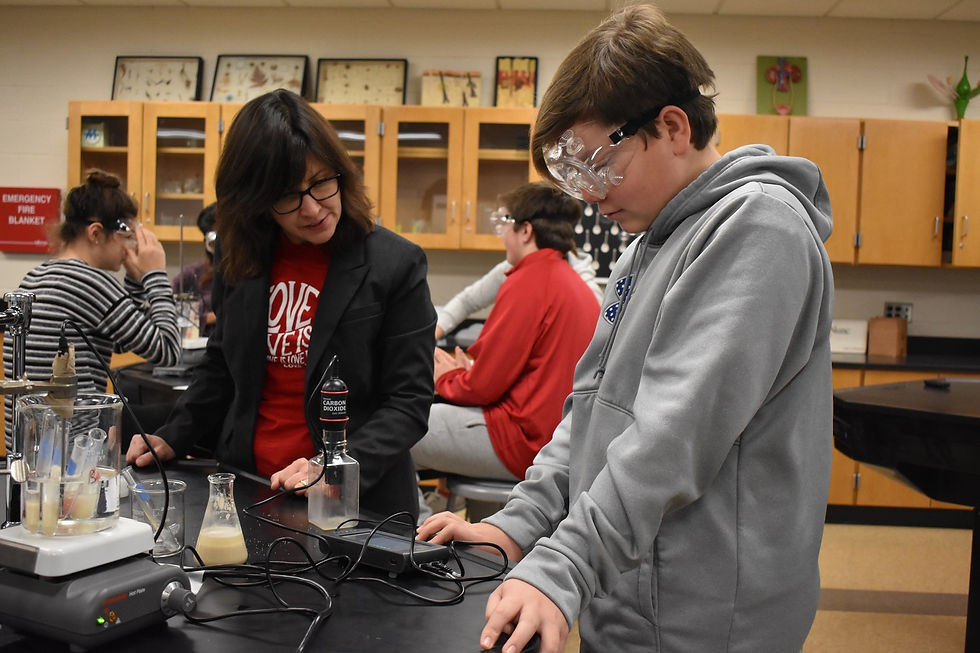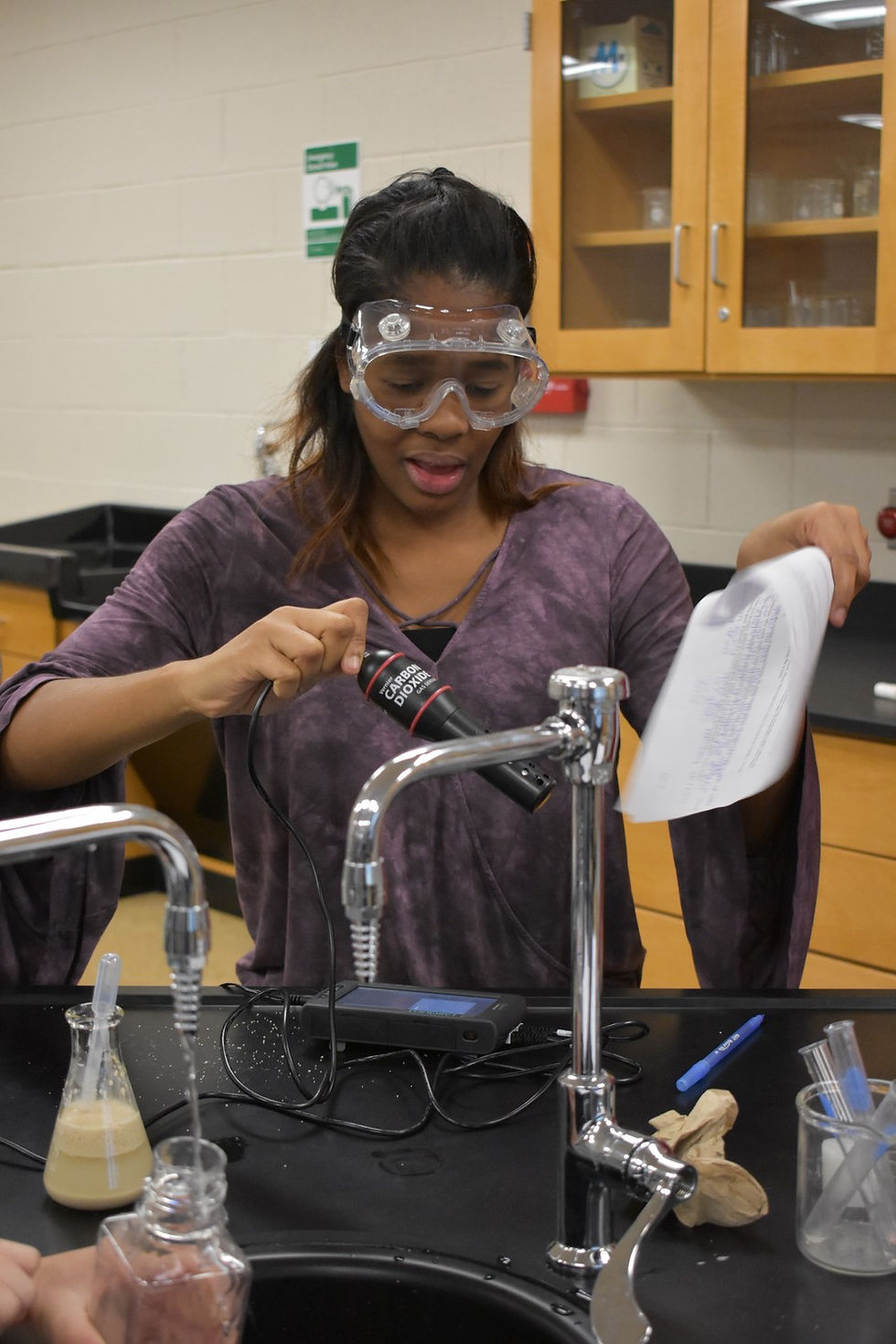South Side High School on cutting edge of evolving classroom practices, thanks in part to the RVC Ed
- By Ben Strack, LIHERALD
- Jan 9, 2018
- 6 min read
Watching a human heart beat up close is an experience reserved for cardiovascular surgeons, and to hold one in your hand sounds like something out of an Edgar Allan Poe poem. Yet at South Side High School in Rockville Centre, students can virtually grab a beating heart from a screen and pull it toward them, examining it from all angles, as vibrations — simulating blood pumping to vital organs — pulse through a stylus and into their hand.“If you put your face slowly into the heart,” teacher Chris D’Ambrosio said, smiling, “you’ll see the inside.”

Chris D’Ambrosio, a science teacher at South Side High School, helped student Emma Garrett use one of the district’s zSpace computers to analyze and label parts of the human body’s circulatory, respiratory and digestive systems. BEN STRACK/HERALD
Exploring in a new way
Analyzing a human heart is just one of the many experiences possible in the Rockville Centre School District’s zSpace lab, which houses 12 computers that combine virtual and augmented reality. With special glasses, students are able to immerse themselves in 3-D, pre-made or teacher-created programs, which give viewers perspectives that they can’t experience in real life.
The students are employing cutting-edge technology. This, educators say, is the future of the 21st century classroom. “You can pull things out, turn them around,” explained D’Ambrosio, whose Living Environment students had just wrapped up a unit on the body’s circulatory, respiratory and digestive systems — more than a month of material — and now were reviewing what they had learned. “. . . If I click on ‘dissect,’ I can pull one of the lobes of the lungs and take a look at the trachea.”
Students from various Living Environment classes gathered in the lab last month, where they were tasked with analyzing and labeling the various anatomical systems and their parts. Once they were finished, the students could download the lesson using eBackpack, an internet-based application, and send it to their teacher, who could then review their answers and address what the students got right and wrong during the next class.
“I thought it was very cool, and I think it’s easier to learn about the systems,” freshman Elio Fontanez said after using the zSpace technology for the first time. “… People would want to do this more. I’d rather do this than stare at a board for 40 minutes.”

Users can virtually grab a beating heart out of the zSpace screen. BEN STRACK/HERALD
The zSpace virtual reality computers were introduced to the district last year as part of a three-year grant from the Rockville Centre Education Foundation, which earmarked $28,000 for the technology this year alone. A total of $6,000 was also used to purchase a ShopBot Indexer, which will allow students to sculpt 3-D models using zSpace programming, according to Audra Cerruto, president of the foundation’s executive board.
“This is where the future is going with technology,” she said. “With that comes untapped potential for utilizing a tool like this to educate our students.”
zSpace computing grabs students’ attention, D’Ambrosio said, comparing it to educational gaming. Aside from examining human hearts, a first-time user can explore the computer’s capabilities on a vibrant home screen. Students can, for example, select a butterfly to pull toward them as it flaps its wings, or a robotic arm that they can “explode” — breaking it into dozens of tiny pieces to observe its many parts — and reassemble again.
Michelle Gamache, a teaching assistant in some of South Side’s biology and chemistry classes, said that students have also dissected cells on the computers. “They’re able to see everything within context . . . because when you’re reading in a book about a cell, you just don’t understand the scale,” she explained. “When you’re seeing it on a zSpace, you’re seeing a cell within the blood, you’re seeing it within an organ, and you’re seeing exactly what we’re talking about.”

Freshmen Billy Talkin, right, and Russell McQuillan, used the zSpace computers. BEN STRACK/HERALD
Teachers were taught how to use the zSpace computers at professional development sessions in August before each of the past two school years, D’Ambrosio said, adding that he often spends his free periods experimenting with how to make lessons more interesting with the 3-D tool.
Principal John Murphy said the school’s biology and art classes have used the zSpace computers the most, and that a dozen teachers have created lessons to use with them. The district plans to expand the use of zSpace, perhaps even allowing elementary and middle school students to try it out.
“It’s really about the questions that it’s posing,” Murphy said. “. . .We envisioned it as a supplement to our instruction, which I guess it has been, but I think . . . it’s forced us to explore what the possibilities are, and that’s the real gift.”
An evolving curriculum
Through new offerings, the district is becoming an example of how classrooms are evolving in an effort to best educate today’s students.
The Rockville Centre Education Foundation, a nonprofit organization formed in 1991 with board members who are educators, local business owners, and parents and grandparents of district children, provides grants for teachers with money raised at an annual gala.
It granted a total of $68,000 to the district last June for this school year to fund 15 initiatives. In addition to the zSpace technology, programs include Dash and Dot Robotics, which gives elementary school students the opportunity to learn coding, and Trout in the Classroom, a program at the high school for which students can hatch, monitor, raise and release trout into the environment.

A robotic arm, which can be taken apart and assembled, is just one of the many programs on the zSpace computers. BEN STRACK/HERALD
“I think that especially with the technology . . . it’s really interdisciplinary,” Cerruto said of today’s curriculum. “It’s not just for the tech class. You’re using technology in art, you’re using technology in science, you’re using technology in “[English Language Arts].”
Separate from foundation-funded programs, South Side is offering a coding elective for the first time as a way to improve students’ computer literacy before college.
A school psychologist and special-education teacher who has taught as a professor at Molloy College for 15 years, Cerruto is also a South Side alumna, and noted that tools like zSpace prepare students for college better than ever before.
“It was great back then,” she said of South Side’s curriculum when she was a student, “but now the opportunities and the breadth and depth of courses are amazing.”
Learning by doing
“Oh my goodness,” said Gamache, who assisted students in D’Ambrosio’s first period class on Dec. 22, when asked how classes are different now than when she went to high school. “I am far older than I look.

Cameron Formes, right, with teaching assistant Michelle Gamache, analyzed the amount of carbon dioxide released during anaerobic respiration of yeast. BEN STRACK/HERALD
A day after running his review session of the body’s circulatory, respiratory and digestive systems, D’Ambrosio made use of another donation from the Education Foundation, as his ninth-graders used Vernier science probes during a lab involving alcohol fermentation.
With the help of D’Ambrosio and Gamache, the students used carbon dioxide sensors to measure how much gas, an end product of anaerobic respiration, was produced in order to determine which sugar — lactose, fructose, glucose or sucrose — is best metabolized by yeast.
The sensors were connected to screens, which displayed the collected data on graphs. Teachers and students can alter the number of recordings that the sensors take per second, as well as the duration they record, D’Ambrosio explained. They can record for five minutes, as is the case in the anaerobic respiration lab, or overnight, to monitor a process like photosynthesis.
Before the carbon dioxide sensors were created, he added, the specific lab he was teaching that day would not have been possible. Students would instead have to put yeast into Erlenmeyer flasks and attach balloons to them to see the gas being produced, which he had done in previous years.
“You would never really get an accurate reading,” D’Ambrosio said.
Once done with the lab, students can scan a Quick Response Code, or QRC, to download the data charts from the screens connected to the sensors onto their iPads, which the district provides for all high school students.

Students used carbon dioxide sensors for their lab on anaerobic respiration. BEN STRACK/HERALD
The school also has respiration monitor belts that measure human breathing, EKG probes that measure voltage produced during the contraction of the heart, and sensors to measure oxygen and pH, the latter replacing the widely known use of colorful pH paper.
“When they get into college,” D’Ambrosio said, “this is what they’re all using, and hopefully [the students will] take this with them.”
Gamache, 45, called her biology class at Ward Melville High School in the 1980s “very dry,” recalling that she and her classmates were told to simply copy information from the textbook onto their lab papers. “You learn better from doing,” she said, “and this gives you the ability to do.”

































Comments